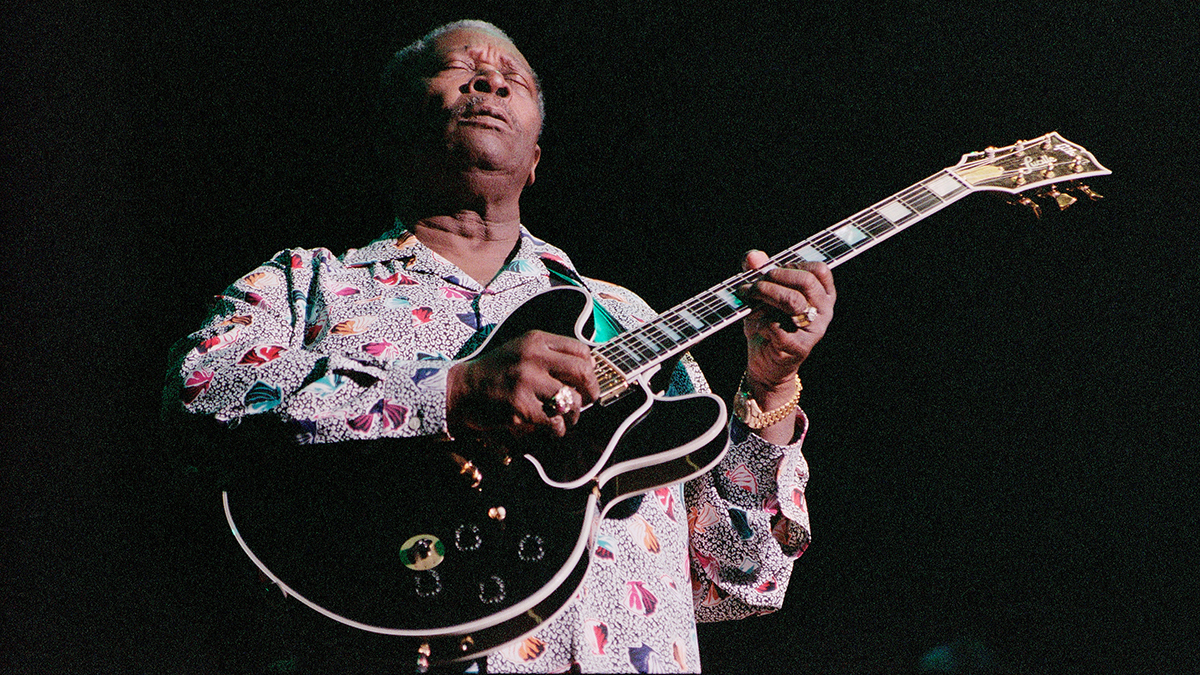Anybody who has picked up the electric guitar owes something to B.B. King – learn how to incorporate his lyrical style and immaculate phrasing into your own playing with these must-try solos
Get to grips with the famed 'B.B. box', sharpen up your vibrato skills and conquer the 12-bar blues in this deep-dive into the King of the Blues' soloing style

There are not many guitarists who can rival the influence of B.B. King, the man often described as the King of the Blues. His pioneering guitar style was the catalyst for a huge number of Chicago blues and eventually rock guitarists, and we dare say that anybody who has picked up the electric guitar owes something to him.
His lyrical style, with its immaculate phrasing, shimmering vibrato, and deeply inherent musicality, is perhaps the pinnacle of expression for which many blues guitarists strive. For more than half a century, King worked tirelessly, releasing over 50 albums and playing upwards of three hundred shows a year and, as a result, he has carved out a legacy that is untouchable.
Born in 1925 on a plantation in Indianola, Mississippi, King’s fascination with music began at an early age while singing in church. He taught himself to play by listening to the radio and set his heart on a career in music. His popularity grew, and a record contract, radio airplay, and tour dates followed. The rest is music history.
King’s style developed from an early love of vocalists. He said himself that his favourite musician was Frank Sinatra, and it is evident that B.B. incorporated this influence into his style, seeing improvising as ‘singing through the instrument’. This quality made him truly special. His style had all the musicality of a great vocalist, and the subtleties in his playing are a huge part of the expression he was capable of.
His phrasing was key to this sound, and each melodic idea was punctuated with space, allowing his solos to breathe. His vibrato also set him apart with its unique quivering style. This gives us some great concepts to take away: to sing like a vocalist when improvising, and that a strong and unique vibrato can become a signature part of one’s sound, adding emotion and expression.
B.B.’s vocabulary was mostly pentatonic-based but also incorporated a jazzy, chord-tone style of improvisation, as he was influenced by Charlie Christian and Django Reinhardt, along with the early Chicago blues men such as T-Bone Walker and Lonnie Johnson.
Our studies incorporate some of these ideas, as well as a pattern referred to as the ‘B.B. Box’. This can be seen as the top three strings of position three of the major pentatonic scale, although it’s really a mix of major and minor, and King would draw from both scales in his solos.
This shape is really a central part of getting King’s style down, as it allows for the first finger to do most of the vibrato work, especially on the root note, which was perhaps one of the most characteristic elements of King’s style. Aim to be as expressive with these solos as possible and, as always, apply the concepts to your own improvising
Get the tone
Amp settings: Gain 2, Bass 4, Middle 5, Treble 6, Reverb 5
B.B. King is famous for his black Gibson ES-355 affectionately named ‘Lucille’, so something similar would get you the closest to his sound. This is not essential, though, as what we are going for is a full-bodied, clean tone with plenty of sparkle, so any guitar will get you close. A fairly liberal application of reverb will help get those bluesy licks sing.
Study 1. Funky blues
This study looks at B.B.’s style over a funky 12-bar backing track. The ‘B.B. box’ shape is employed through much of this track but, notice how the emphasis is on creating musical phrases rather than running through a scale.
Aim to include some variation in dynamics, as this will give the solo a more musical quality. The backing track can be found below.
Study 2. Slow 12/8 blues
Our second solo is over a slow blues. The rhythmic feel is important here, so experiment with slight variations against the underlying 12/8 feel. This is similar to how a crooner like Sinatra may approach a song, pushing and pulling phrases. The vibrato and articulations are another important factor in this solo, so aim to capture this element.
Notice the Cm9 arpeggio over the F7 chord – this is a very cool sound that B.B. would have borrowed from his jazz influences. Again, the backing track can be found below.
Get The Pick Newsletter
All the latest guitar news, interviews, lessons, reviews, deals and more, direct to your inbox!
David is a guitarist, producer, and educator. He has performed worldwide as a session musician, with artists and bands spanning many musical genres. He draws upon over 20 years of experience in both live performance and studio work, as well as numerous composing credits. As a producer, he's collaborated with artists across genres, including pop, RnB, and neo soul. David holds a master’s in jazz guitar and teaches at BIMM London and the London College of Music. He is also a regular contributor to Guitar Techniques magazine, sharing his love of blues in a monthly column.
“There are so many sounds to be discovered when you get away from using a pick”: Jared James Nichols shows you how to add “snap, crackle and pop” to your playing with banjo rolls and string snaps
Don't let chord inversions bamboozle you. It's simply the case of shuffling the notes around









![Joe Bonamassa [left] wears a deep blue suit and polka-dotted shirt and plays his green refin Strat; the late Irish blues legend Rory Gallagher [right] screams and inflicts some punishment on his heavily worn number one Stratocaster.](https://cdn.mos.cms.futurecdn.net/cw28h7UBcTVfTLs7p7eiLe.jpg)


